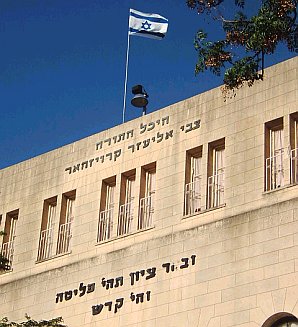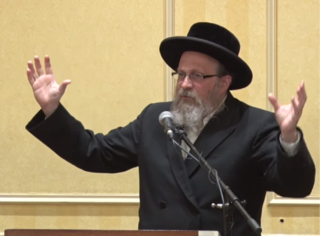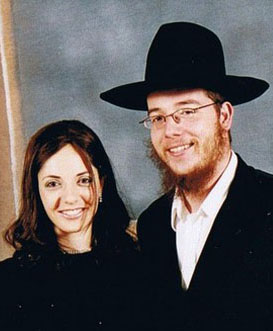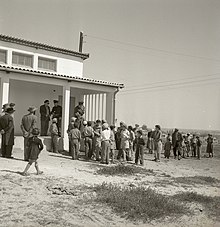
The Qibya massacre occurred during "Operation Shoshana", a reprisal operation that occurred in October 1953 when Israeli troops under Ariel Sharon attacked the village of Qibya in the West Bank, which was then under Jordan's control, and killed Palestinian civilians.

Chabad, also known as Lubavitch, Habad and Chabad-Lubavitch, is an Orthodox Jewish Hasidic dynasty. Chabad is one of the world's best-known Hasidic movements, particularly for its outreach activities. It is one of the largest Hasidic groups and Jewish religious organizations in the world. Unlike most Haredi groups, which are self-segregating, Chabad operates mainly in the wider world and caters to secularized Jews.

770 Eastern Parkway, also known as "770", is the street address of the World Headquarters of the Chabad-Lubavitch Hasidic movement, located on Eastern Parkway in the Crown Heights section of Brooklyn, New York, in the United States. The building is the center of the Chabad-Lubavitch world movement, and considered by many to be an iconic site in Judaism.

Givat Shaul is a neighborhood in West Jerusalem. The neighborhood is located at the western entrance to the city, east of the neighborhood of Har Nof and north of Kiryat Moshe. Givat Shaul stands 820 meters above sea level.

The Gan Israel Camping Network is a group of Chabad-Lubavitch summer camps. The network claims a total enrolment of over 100,000 children.

From the founding of political Zionism in the 1890s, Haredi Jewish leaders voiced objections to its secular orientation, and before the establishment of the State of Israel, the vast majority of Haredi Jews were opposed to Zionism, like early Reform Judaism, but with own reson. This was chiefly due to the concern that secular nationalism would redefine the Jewish nation from a religious community based in their alliance to God for whom adherence to religious laws were “the essence of the nation’s task, purpose, and right to exists,” to an ethnic group like any other as well as the view that it was forbidden for the Jews to re-constitute Jewish rule in the Land of Israel before the arrival of the Messiah. Those rabbis who did support Jewish resettlement in Palestine in the late 19th century had no intention to conquer Palestine and declare its independence from the rule of the Ottoman Turks, and some preferred that only observant Jews be allowed to settle there.

Kfar Chabad is a Chabad-Lubavitch village in central Israel. Between Beit Dagan and Lod, it falls under the jurisdiction of Sdot Dan Regional Council. In 2021 it had a population of 6,797.

Rabbi Moshe Weinberger is an American Chasidic rabbi, educator, author, translator, and speaker. He is the founding rabbi of Congregation Aish Kodesh in Woodmere, New York, and former Mashpia/mashgiach ruchani at the Rabbi Isaac Elchanan Theological Seminary (RIETS). He has recorded more than 5000 lectures on chasidic thought and philosophy as well as Halakha and a variety of other topics in Judaism.

Bar'am, also Baram, is a kibbutz in northern Israel. Located approximately 300 meters from Israel's border with Lebanon near the ruins of the ancient Jewish village of Kfar Bar'am. Bar'am National Park is known for the remains of one of Israel's oldest synagogues. The kibbutz falls under the jurisdiction of Upper Galilee Regional Council and had a population of 647 in 2021.

Beit Hagai, also Hagai, is an Israeli settlement organized as a community settlement located in the southern Hebron hills in the West Bank. The settlement population was 460 in 2004, according to a classified government document published by the Haaretz newspaper, and lies within the municipal jurisdiction of the Har Hevron Regional Council. The religious Jewish community's name, Haggai, is an acronym of the given names Hanan Krauthammer, Gershon Klein, and Yaakov Zimmerman, three Nir Yeshiva students murdered in the 1980 Hebron terrorist attack. The community rabbi for Beit Hagai is Rabbi Moshe Eliezer Rabinovich (HaLevy). In 2021 it had a population of 701. The international community considers Israeli settlements in the West Bank illegal under international law, but the Israeli government disputes this.

Yitzchak Feivish Ginsburgh sometimes referred to as "the Malakh" is an American-born Israeli rabbi affiliated with the Chabad movement. In 1996 he was regarded as one of Chabad's leading authorities on Jewish mysticism. He is the leader of the Derech Chaim Movement and founder of the Gal Einai Institute, which publishes his written works. His students include Charedim, religious Zionists, and Chabad Chassidim, as well as ba'alei teshuvah. He is currently the president of a number of educational institutions, including the Od Yosef Chai yeshiva in the settlement of Yitzhar in the West Bank. Ginsburgh has lectured in various countries, and throughout Israel. His teachings cover subjects including science, psychology, marital harmony and monarchy in Israel. He has published over 100 books in Hebrew and English, most of which are edited by his students.

Gavriel Noach Holtzberg (Hebrew: גבריאל נח הולצברג; June 9, 1979 – November 26, 2008 was an Israeli American Orthodox rabbi and the Chabad emissary to Mumbai, India, where he and his wife Rivka ran the Mumbai Chabad House. He was also a religious leader and community builder for the local Jewish Indian community, and led the Friday-night Shabbat services at the Knesset Eliyahoo synagogue. Holtzberg and his wife were murdered during the 2008 Mumbai attacks perpetrated by Islamic militant group Lashkar-e-Taiba.
Events in the year 1956 in Israel.
Events in the year 1953 in Israel.
The Yehud attack was an attack on a civilian house in the village of Yehud carried out by a Palestinian fedayeen squad on 12 October 1953. Three Israeli Jewish civilians were killed in the attack.

The Khan Yunis massacre took place on 3 November 1956 in the Palestinian town of Khan Yunis and the nearby refugee camp of the same name in the Gaza Strip during the Suez Crisis.

The Palestinian Fedayeen insurgency was an armed cross-border conflict, which peaked between 1949 and 1956, involving Israel and Palestinian militants, mainly based in the Gaza Strip, under the nominal control, of the All-Palestine Protectorate – a Palestinian client-state of Egypt declared in October 1948, which became the focal point of the Palestinian fedayeen activity. The conflict was parallel to the Palestinian infiltration phenomenon. Hundreds were killed in the course of the conflict, which declined after the 1956 Suez War.

















